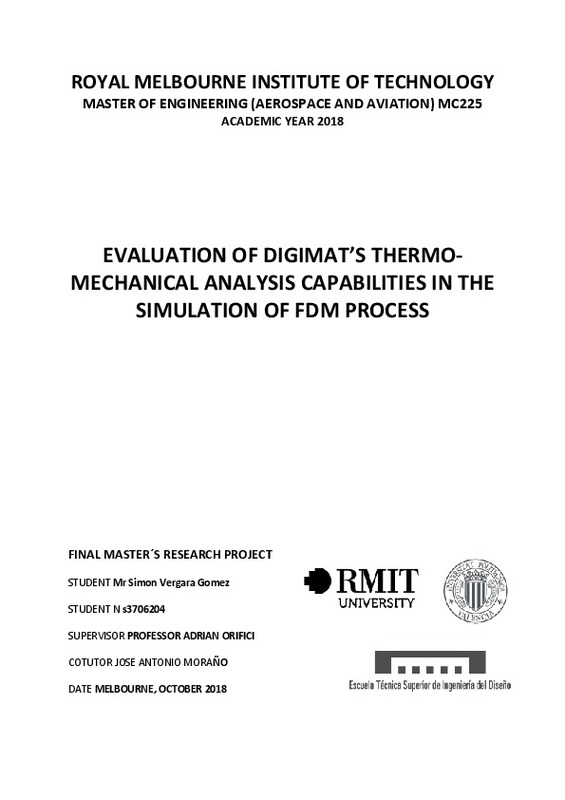|
Resumen:
|
[ES] "Impresión 3D" es un término común usado para describir el proceso de Fabricación Aditiva, la cual incluya una variedad de técnica entre las cuales se pueden destacar la FDM. Esta tecnología está siendo ampliamente ...[+]
[ES] "Impresión 3D" es un término común usado para describir el proceso de Fabricación Aditiva, la cual incluya una variedad de técnica entre las cuales se pueden destacar la FDM. Esta tecnología está siendo ampliamente adoptada en una gran variedad de áreas incluyendo medicina, prototipos y textil. Sin embargo, debido a la naturaleza anisotrópica de las partes fabricadas, es necesaria cierta investigación antes de ampliar su uso a la industria aeronáutica. Durante el proceso de impresión, la pieza es expuesta a un continuo perfil termomecánico variable, el cual induce tensiones residuales y provoca que la geometría sea considerablemente distinta a la diseñada. Como resultado, el desempeño y el comportamiento mecánico de las partes impresas pueden verse considerablemente afectados. La simulación de Elementos Finitos puede ofrecer una solución eficaz, previendo esta variabilidad y ahorrando tiempos de procesado y costes. Por otro lado, los softwares disponibles presentan ineficiencias debido a su capacidad de solucionar el proceso termomecánico y sus simplificaciones. Por ello, no son recomendables para analizar el comportamiento de piezas con geometrías complejas o expuestas a ciertos esfuerzos. En este trabajo, se estudia el innovador software Digimat, analizando su habilidad para simular el proceso de FDM con partes fabricadas con ULTEM 9085, un termoplástico pionero recientemente certificado, usado para la producción de componentes no estructurales de aeronaves civiles. La capacidad de Digimat es validada mediante datos experimentales de la literatura, llevando a cabo varios test para medir su eficiencia y precisión. Una vez el software ha sido validado, una geometría de interés es estudiada llevando a cabo un estudio paramétrico de las variables de impresión como ángulo de impresión, anchura,... tratando de analizar cómo afectan al comportamiento mecánico. Finalmente, las capacidades y limitaciones de Digimat son establecidas llevando a cabo distintos análisis de piezas con geometrías más complejas y bajo diferentes cargas, comparando los resultados con resultados analíticos y/o experimentales. Este estudio será de interés para el sector aeronáutico a medio/largo plazo, consiguiendo una considerable mejora de la productividad.
[-]
[EN] 3D-printing is a common term used to describe the Additive Manufacturing process, which includes a variety of techniques and amongst the ones it could be highlighted the Fused Deposition Modelling (FDM). This technology ...[+]
[EN] 3D-printing is a common term used to describe the Additive Manufacturing process, which includes a variety of techniques and amongst the ones it could be highlighted the Fused Deposition Modelling (FDM). This technology is being widely adopted in a variety of areas including medicine, rapid prototyping and textile; however, due to the anisotropic nature of the manufactured parts, some research is needed before making use of this technology in the aeronautical sector. During the printing process, the part is exposed to a constant varying thermo-mechanical profile, which induced residual stresses and causes the geometry to be significantly different to the designed one. As a result, the performance and mechanical behaviour of FDM printed part could be considerably affected. FE simulation of the process could offer a powerful solution, foreseeing this variability and saving processing times and costs. Nevertheless, the available software present gaps and inefficiencies due to its thermo-mechanical solving methodology and its processing simplification assumptions. Therefore, they are not suitable to analyse the performance of parts with complex geometries or under certain loadings. In this paper, the state-of-the-art software Digimat is studied and analysed to evaluate its ability to simulate the FDM printing process of ULTEM 9085 parts, a certificated pioneering thermoplastic which has been used for the production of interior components of civil aircraft. Digimat s performance is validated with experimental data from the available literature, performing multiple tests (tensile, compression ) in order to measure its accuracy. Once the software is tested, a geometry of interested is chosen, and a parametric studio of the different printing variables (air gap, raster angle, orientation, layer thickness) is carried out with the objective of understanding how the mechanical properties are affected and optimising them. Finally, the capabilities and limitations of Digimat are established by carrying out analysis of parts with complex geometries and under different loadings and comparing the results with both analytical and experimental results. As a medium to long-term goal, this study will be of interest to aeronautical enterprises, achieving a considerable improvement of its productivity by adopting the FDM process.
[-]
|







